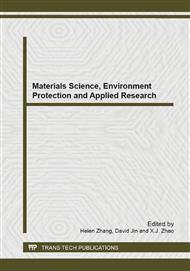[1]
T.T.H. Hoa, L.N. Khanh, Z.J. Liu, T. Fujii, J.D. Rouse, K. Furukawa. Nitrogen removal by immobilized anammox sludge using PVA Gel as biocarrier: Jpn. J. Water Treat. Biol. Vol. 42 (2006), pp.139-149.
DOI: 10.2521/jswtb.42.139
Google Scholar
[2]
J.M. Regan, G.W. Harrington, D.R. Noguera. Ammonia- and nitrite-oxidizing bacterial communities in a pilot scale chloraminated drinking water distribution system: Appl Environ Microbiol. Vol. 68 (2002), pp.73-81.
DOI: 10.1128/aem.68.1.73-81.2002
Google Scholar
[3]
M.T.T. Lipponen, P.J. Martikainen, R.E. Vasara, K. Servomaa, O. Zacheus, M.H. Kontro. Occurrence of nitrifiers and diversity of ammonia-oxidizing bacteria in developing drinking water biofilms: Water Res. Vol. 38 (2004), pp.4424-4434.
DOI: 10.1016/j.watres.2004.08.021
Google Scholar
[4]
Y.Z. Peng, G. Zhu. Biological nitrogen removal with nitrification and denitrification via nitrite pathway: Appl. Microb. Biotechnol. Vol. 73 (2006), pp.15-26.
DOI: 10.1007/s00253-006-0534-z
Google Scholar
[5]
W. Bae & J.W. Chung. Optimal operational factors for nitrite accumulation in batch reactors: Biodegradation. Vol. 12 (2002), pp.359-366.
Google Scholar
[6]
D.U. Van, M.S.M. Jetten, M.C.M. Van Loosdrecht. The SHARON-Anammox- process for treatment of ammonium rich wastewater: Water Sci. Technol. Vol. 44 (2001), pp.153-160.
DOI: 10.2166/wst.2001.0037
Google Scholar
[7]
O. Turk & D.S. Mavinic . Stability of nitrite build-up in an activated sludge system: J. Water Pollut. Control Fed. Vol. 61 (1989), pp.1440-1448.
Google Scholar
[8]
Y.Y. An, F.L. Yang, H.C. Chua, F.S. Wong, B. Wu. The integration of methanogenesis with shortcut nitrification and denitrification in a combined UASB with MBR: Bioresource Technology. Vol. 99 (2008), pp.3714-3720.
DOI: 10.1016/j.biortech.2007.07.020
Google Scholar
[9]
Y.Z. Peng, S. Gao, S. Wang, L. Bai. Partial nitrification from domestic wastewater by aeration control at ambient temperature: Chinese J. Chem. Eng. Vol. 15 (2007), pp.115-121.
DOI: 10.1016/s1004-9541(07)60043-3
Google Scholar
[10]
T. Khin, A.P. Annachhatre. Novel microbial nitrogen removal processes: Biotechnol. Adv. Vol. 22 (2004), 519-532.
DOI: 10.1016/j.biotechadv.2004.04.003
Google Scholar
[11]
S. Philips, H.J. Laanbrock, W. Verstraete. Origin causes and effects of increased nitrite concentrations in aquatic environments. Reviews in Environmental Science and Bio/Technology. Vol. 1 (2002), pp.115-141.
DOI: 10.1023/a:1020892826575
Google Scholar
[12]
A. Guisasola, I. Jubany, J.A. Baeza, J. Carrera, J. Lafuente. Respirometric estimation of the oxygen affinity constants for biological ammonium and nitrite oxidation. J. Chem. Technol. Biotechnol. Vol. 80 (2005), pp.388-396.
DOI: 10.1002/jctb.1202
Google Scholar
[13]
Y.Z. Peng, Y. Chen, C.Y. Peng, M. Liu, S.Y. Wang, X.Q. Song, Y.W. Cui. Nitrite accumulation by aeration controlled in sequencing batch reactors treating domestic wastewater. Water Sci. Technol. Vol. 50 (2004), pp.35-43.
DOI: 10.2166/wst.2004.0603
Google Scholar
[14]
C. Picioreanu, M.C.M. van Loosdrecht, J.J. Heijnen. Modelling of the effect of oxygen concentration on nitrite accumulation in a biofilm airlift suspension reactor. Water Sci Technol. Vol. 36 (1997), pp.147-156.
DOI: 10.2166/wst.1997.0034
Google Scholar
[15]
F. Cecen and I.E. Gonenc. Nitrogen removal characteristics of nitrification and denitrification filters. Wat. Sci. Tech. Vol. 29 (1994), pp.409-416.
Google Scholar
[16]
A. Pollice, V. Tandoi, C. Lestingi. Influence of aeration and sludge retention time on ammonium oxidation to nitrite and nitrate. Water Res. Vol. 36 (2002), pp.2541-2546.
DOI: 10.1016/s0043-1354(01)00468-7
Google Scholar
[17]
G. Ruiz, D. Jeison, R. Chamy. Nitrification with high nitrite accumulation for the treatment of wastewater with high ammonia concentration. Water Res. Vol. 37 (2003), pp.1371-1377.
DOI: 10.1016/s0043-1354(02)00475-x
Google Scholar
[18]
R. Canziani, V. Emondi, M. Garavaglia, F. Malpei, E. Pasinetti, G. Buttiglieri. Effect of oxygen concentration on biological nitrification and microbial kinetics in a crossflow membrane bioreactor (MBR) and moving-bed biofilm reactor (MBBR) treating old landfill leachate. Journal of Membrane Science, Vol. 286 (2006).
DOI: 10.1016/j.memsci.2006.09.044
Google Scholar
[19]
T. Hidaka, H. Yamada, M. Kawamura, H. Tsuno. Effect of dissolved oxygen conditions on nitrogen removal in continuously fed intermittent-aeration process with two tanks. Water Sci Technol Vol. 45 (2002), pp.181-188.
DOI: 10.2166/wst.2002.0425
Google Scholar
[20]
H.S. Yoo, K.H. Ann, H.J. Lee, K.H. Lee, Y.J. Kwak, K.G. Song. Nitrogen removal from synthetic wastewater by simultaneous nitrification and denitrification (SND) via nitrite in an intermittently aerated reactor. Water Res. Vol. 33 (1999).
DOI: 10.1016/s0043-1354(98)00159-6
Google Scholar
[21]
H.J. Yoon & D.J. Kim. Nitrification and nitrite accumulation characteristics of high strength ammonia wastewater in a biological aerated filter. J. Chem. Tech. Biotechnol. Vol. 78 (2003), pp.377-383.
Google Scholar
[22]
G. Camilla & D. Gunnel. Development of nitrification inhibition assays using pure cultures of Nitrosomonas and Nitrobacter. Water Res. Vol. 35(2001), pp.433-440.
DOI: 10.1016/s0043-1354(00)00312-2
Google Scholar
[23]
J.W. Mulder, M.C.M. van Loosdrecht, C. Hellinga, R. van Kempen. Full-scale application of the SHARON process for the treatment of rejection water of digested sludge dewatering. Water Sci Technol. Vol. 43 (2001), pp.127-134.
DOI: 10.2166/wst.2001.0675
Google Scholar
[24]
C. Helmer & S. Kunst. Simultaneous nitrification/denitrification in an aerobic biofilm system. Water Sci. Technol., Vol. 37(1998), pp.183-187.
DOI: 10.2166/wst.1998.0615
Google Scholar
[25]
P. Zheng, X.L. Xu, B.L. Hu. Novel theories and technologies of biological nitrogen removal. Science, Beijing, (2004).
Google Scholar


